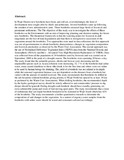| dc.description.abstract | In Wajir District new boreholes have been, and still are, overwhelmingly the form of development most sought after by chiefs and politicians. Several boreholes came up following the creation of new administrative units. These boreholes attracted large herds of livestock and permanent settlements. The
The objective of this study was to investigate the effects of these boreholes on the
Environment with an aim of improving planning and decision making for
future new boreholes. The theoretical framework is that the watering points for livestock in arid rangelands are the foci of land degradation and that there
is retrogressive succession of the vegetation around the boreholes.
Two approaches were used in data collection; the first approach was use of questionnaires to obtain boreholes characteristics, changes in vegetation composition and livestock production as observed by the Water User Association. The second approach was the use of Normalised Difference Vegetation Index (NDVI) data from the National Oceanic and Atmospheric (NOAA) satellite's - Advanced Very High Resolution Radiometer (A VHRR).
Data was collected from all the population of 34 boreholes used by livestock and was carried out in September, 2009 at the peak of a drought season. The boreholes were operating 20 hours a day. The study found that the palatable grasses, shrubs and browse were decreasing and the unpalatable species such as Acacia reficiens were increasing. 52. 7 % of the boreholes had saline water, some caused diarrhoea to those who drank it for the first time and others were too saline to be used by human beings for drinking.
The yield of a borehole was not related to its depth while the seasonal vegetation biomass was not dependent on the distance from a borehole but varied with the amount of rainfall received.
The study recommends that boreholes be drilled in the sub-locations without boreholes giving priority to Wajir North but spaced by at least 30 km as preferred by the Water User Associations. When drilling boreholes, the recommended depth by the hydro-geological survey should be strictly adhered to and communities' pressure to dig deeper should be ignored. During drought each borehole should have standby generating set, extra submersible pump and stock of fast moving spare parts. The study recommends that a team of technicians that can repair borehole breakdowns be stationed in Wajir South which has 42% of the boreholes. The study recommends a further quantitative research to determine the composition of and changes in the vegetation. As a matter of urgency water samples from the boreholes with saline water should be tested and consumers advised accordingly. | en_US |

